Newport launched more slave trading voyages than anywhere else on the continent. Local efforts and a state law now push students to learn that history.
By Asher Lehrer-Small, The 74 —
Every year, Newport welcomes millions of tourists who marvel at the city’s colonial architecture, savor lobster rolls on the wharf and gaze at waters that — many don’t realize — launched more slave trading voyages than anywhere else in North America.
“If you were to ask people to name a state involved in the business of slavery, Rhode Island probably would never come up,” University of Wisconsin-Madison professor Christy Clark-Pujara told The 74.
But efforts underway in the Ocean State now seek to shed light on its past, and they’re already impacting how some young Newporters interact with the city they call home.
A few blocks from the cobblestoned downtown thoroughfares and not far from the perfectly preserved Gilded Age mansions that visitors flock to, a mostly empty parking lot catches the eye of Gabrielle Brown.
The high schooler learned during a freshman-year history course that the site is rumored to have once been an enslaved African woman’s bakery. Taken from West Africa and brought to Rhode Island in the 18th century, Charity “Duchess” Quamino became known as the city’s “Pastry Queen” for her catering business that, some say, served George Washington during a local visit — and eventually bought her freedom.
The teen pauses to picture Quamino’s day-to-day routine.
“I just stood there and imagined what it would have been like as a bakery … trying to imagine what life was like then for Black people in Newport,” she said.
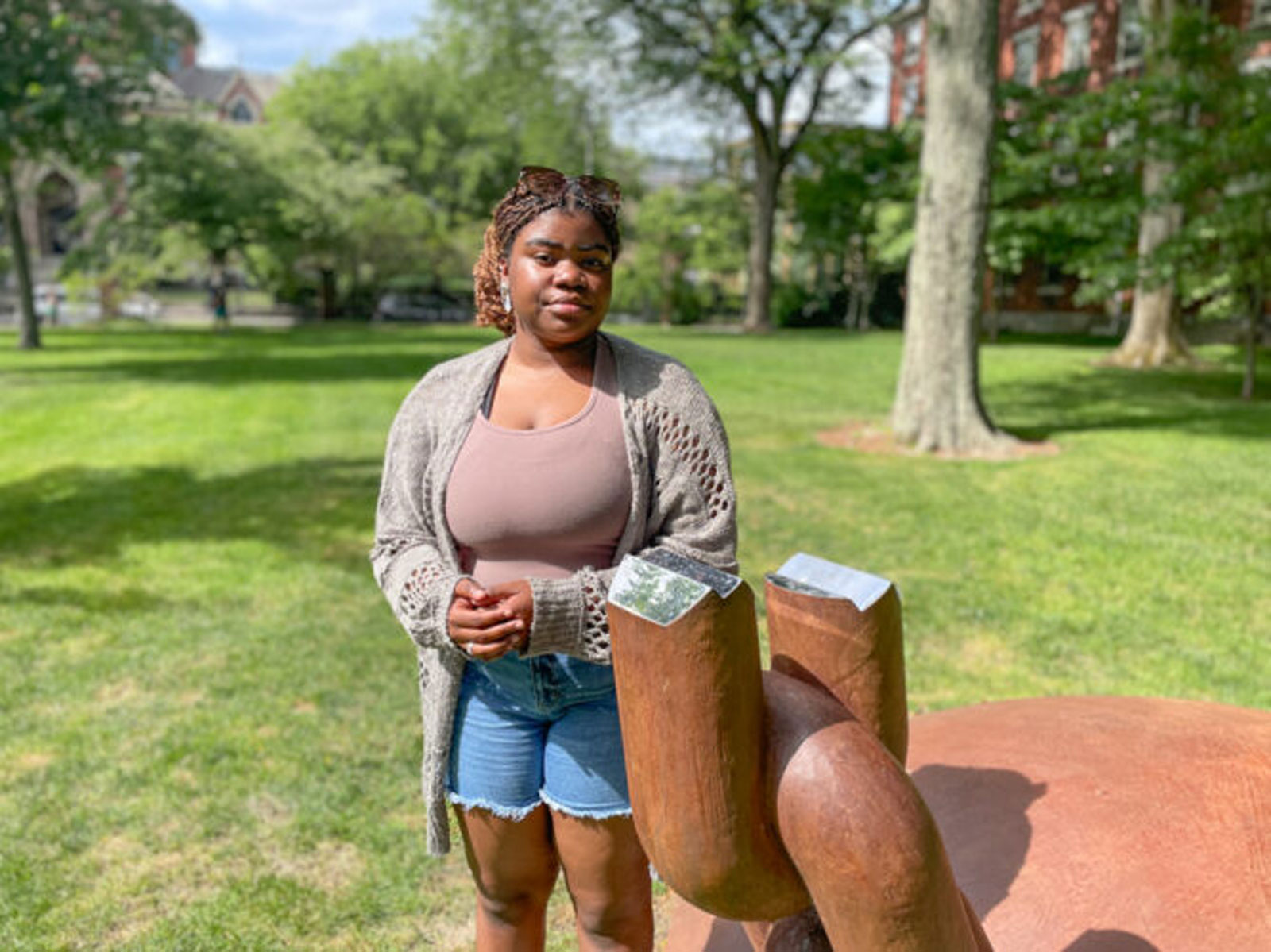
Gabrielle Brown stands next to a memorial at Brown University acknowledging that the school financially benefited from Rhode Island’s involvement in the slave trade. (Asher Lehrer-Small)
Though the Pastry Queen and figures like her helped build Newport — some, literally — they don’t show up in history textbooks and, until recently, have been mostly absent from residents’ collective memory.
But in 2021, Gov. Dan McKee signed into law a bill requiring curriculum to include teachings on Rhode Island’s “African Heritage History” by the 2022-23 school year. Advocates call it among the most comprehensive efforts nationwide to teach local Black history. Now, districts across the state are striving to incorporate lessons like the one that inspired Brown to envision a past about which she otherwise may never have learned.
The move comes as conservative activists — here and across the nation — rally to curtail classroom lessons around race. For Clark-Pujara, Rhode Island’s African heritage efforts are a step toward learning about histories that have been “intentionally disremembered.”
Some 60% of all slave trading voyages that launched from North America — amounting to 945 trips between 1700 and 1850 — began in tiny Rhode Island. In some years, it was more than 90% and most of those journeys set out from Newport, making it the most trafficked slaving port of origin on the continent.
“The streets of Newport were paved with the duties paid on enslaved people,” said the UW-Madison scholar, who wrote the book Dark Work: The Business of Slavery in Rhode Island.
“You have an entire economy that is wrapped up in the business of slavery.”

Christy Clark-Pujara (Choices Program)
Although the city of 25,000 people is now over 80% white and only 8% Black, in the mid-1700s, approximately a quarter of Newport’s population was Black or African, the second-highest share in the U.S. at the time behind Charleston, South Carolina. Early Black Newporters were among the first African Americans in the U.S. to attend college and launched the nation’s first African mutual aid society.
For young people like Brown, the impact of learning about what local historian Keith Stokes calls the “creative survival” of colonial-era Black residents is tremendous.
“Newport, I think the way it’s advertised is just boats … you know, bring your salmon-colored shorts and I just don’t want to be here. But once you are able to learn Newport’s history holistically, there’s just so much more to appreciate,” said the rising senior.
“Now it’s like there’s something there for me and I can really appreciate the space that I’m in.”
LISTEN
Gabrielle Brown, on the steps of the Newport Historical Society, describes the personal impact of learning local Black history.
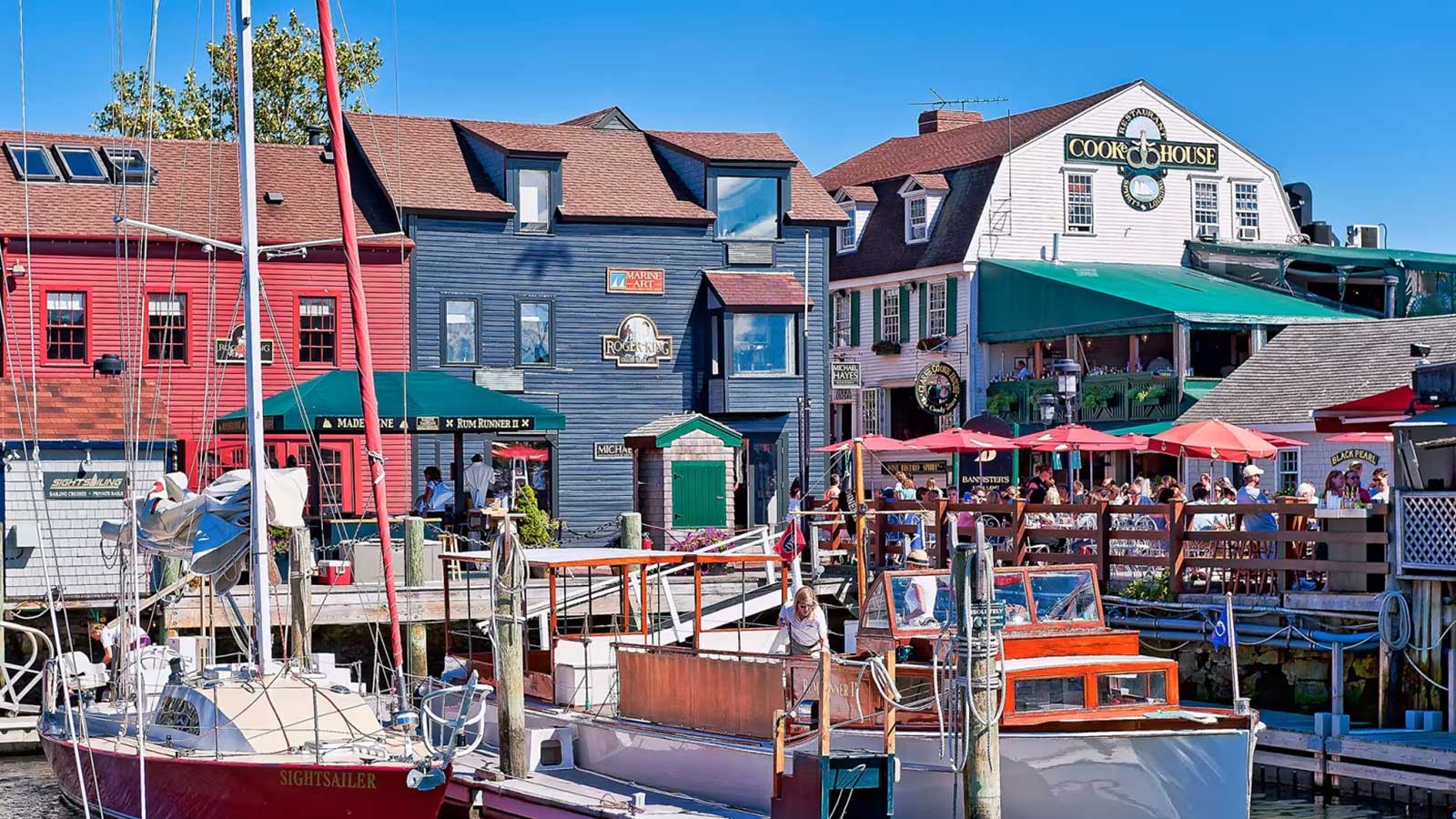
Bowen’s Wharf in downtown Newport (John Greim/Getty Images)
‘I think that slavery happened here. Maybe.’
The steps toward reckoning with the city’s historical role in the slave trade come on the heels of decades of silence.
“It’s never been taught,” said Victoria Johnson, 81, who was a longtime teacher and eventually became the state’s first black female principal before retiring from Newport’s Rogers High School in 2003.
The pioneering Black educator grew up in a mostly segregated Newport and her memory of the discrimination still stings: being prevented from eating an ice cream cone at the counter of the five-and-dime store where she purchased it, the difficulty of finding a high school job. It wasn’t until college when she stumbled across a document on Newport Gardner, a Black 18th-century Newporter who made a name for himself as a musician, that she began to understand the full history of the city she was raised in.
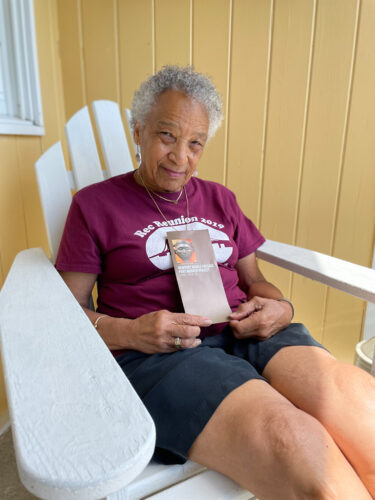
Victoria Johnson holds a brochure from the Newport Middle Passage Port Marker Project, an initiative she co-founded to memorialize the contributions of early Black residents and to recognize the city’s role in the slave trade. (Asher Lehrer-Small)
Later, as an employee of the district, she remembers being required to take a Newport and Rhode Island history course because she attended a university out of state. The course, however, made no mention of African Americans’ contributions. And while she recalls lessons covering the region’s key business exports, they did not touch on the slave trade.
“I was never taught any of that in that course,” Johnson told The 74.
Akeia de Barros Gomes works as a curator at the Mystic Seaport Museum in nearby Connecticut. Like Johnson, she grew up in Newport, and like her, it wasn’t until de Barros Gomes went elsewhere that she learned the rich history of people who looked like her in the city.
“I didn’t know anything about Black history in Newport until I left and was a grad student and started looking into it as an academic,” she said. “I didn’t get any of it growing up. There are no places on the landscape that indicate that there was any Black history in Newport — ever.”
While researching for her doctorate degree around 2005, de Barros Gomes asked her mother, who was working at a Newport elementary school, to help with an informal educator poll. About two dozen teachers were given maps of Newport with instructions to draw an “X” at any site of Black history. Only one map was returned with any marks at all.
“I was shocked,” said the researcher. “There was room for comments and one of the teachers said, ‘I think that slavery happened here. Maybe.’”
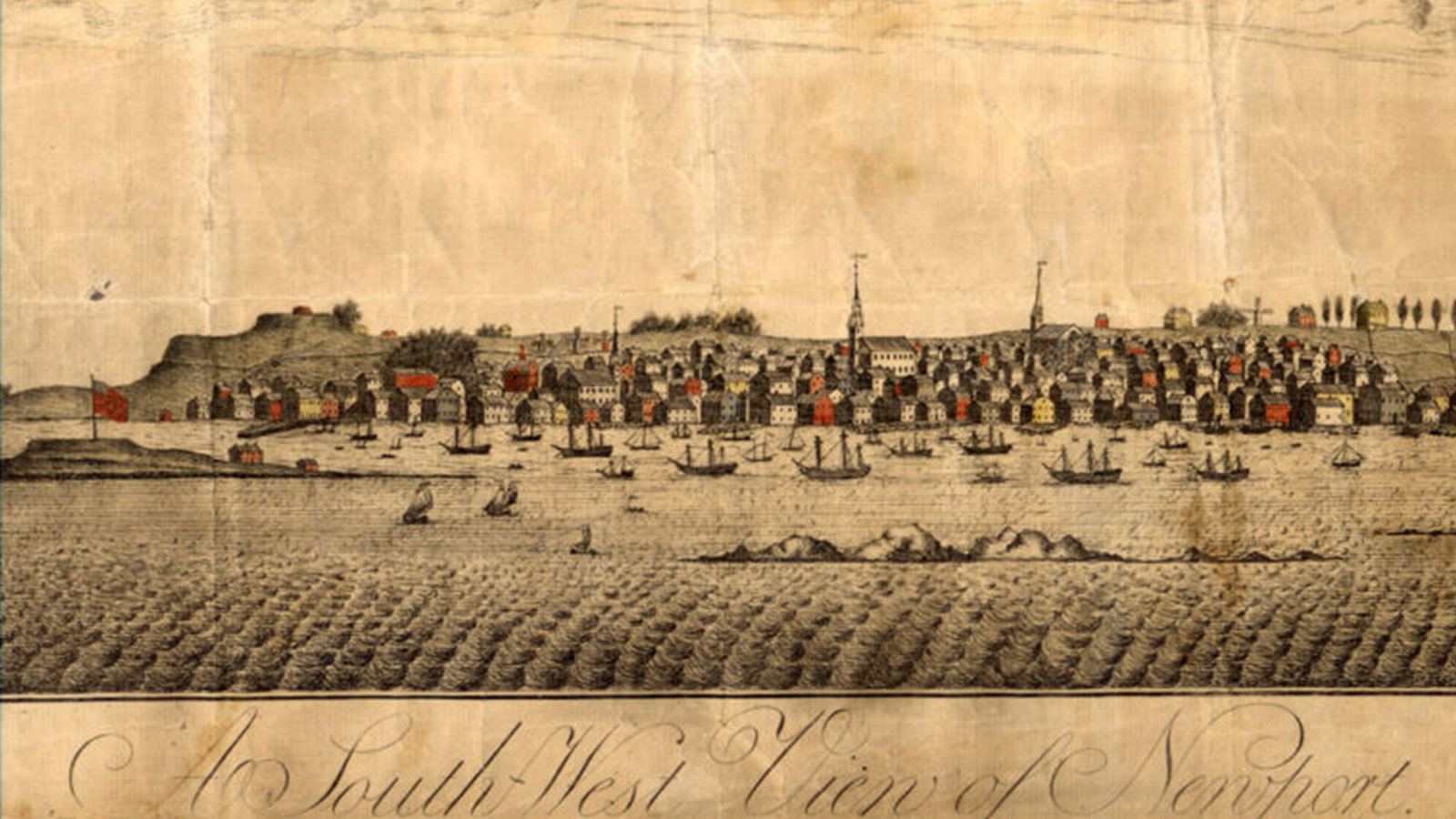
A depiction of Newport harbor in 1795. (92.7.1, Collection of the Newport Historical Society)
‘Definite progress’
The story is different — at least to a degree — for students and teachers today.
Via public record requests, The 74 obtained curricula, lesson plans and classroom handouts from social studies classes in Newport. Required 10th and 11th grade history courses now include teachings on Black business leaders in Newport and weave in lessons on Rhode Island’s role in the slave trade, the documents show. A ninth grade Black history activity highlights the contributions of 19th and 20th century African American Newporters.
“Our social studies department is committed to incorporating local Newport history and early Black life into the curriculum,” Christopher Ashley, the district’s director of teaching, learning & professional development, told The 74 in an email.
“Our teachers acknowledge Newport’s history in the slave trade and work to help students think deeply about the historical context of Newport and the colonial slave trade overall.”
In 2016, the high school launched a half-credit state history elective, where students can dig deeper into those topics. However, after being offered three years in a row, the district said the course was cut the last three years because too few students signed up. The high school will decide in August whether it will be taught this fall, said Superintendent Colleen Jermain.
“Whenever you tell the history of slavery, you must tell the history of resistance.” — Christy Clark-Pujara
Despite these efforts, youth say their history classes mostly skirted some of the more difficult lessons. In Cooper’s memory, discussions of Rhode Island’s role in the slave trade were few and far between.
“In school, we’re talking about the fact that the slave trade exists, but it’s always something they associate with the South,” said the rising senior.
“It’s just not true. The North was very much involved.”
Compared to other Rhode Island districts, however, Newport may be ahead of the curve. Less than half of high schools in the state as of June 2021 ran a standalone course devoted to local and state history, according to University of Edinburgh graduate student Grace King, who provided her history dissertation on the subject to The 74. Of the 12 schools that do, Rogers High School was in a three-way tie with Cranston and East Provdence for the largest reported share of time spend learning about slavery in Rhode Island: 20%.
Of all 34 schools from which King collected data (more than 80% of Rhode Island’s high schools), most social studies teachers said they include information on local history, including on Rhode Island’s role in the slave trade, in their classes, even if they do not have a separate elective course.
“Rhode Island high schools — Newport included — have clearly begun to incorporate lessons reckoning with its slave trading history, but have further progress still to make,” King said in an email to The 74.
In Newport’s elective course, a document-based question asks students “How did the economy of colonial Rhode Island become dependant on the Transatlantic slave trade?” and recommended sources include an article describing a back-to-Africa movement pioneered by colonial Black Newporters.
Covering those topics represents “definite progress,” said Clark-Pujara, who has long critiqued the state’s history lessons. In 2018, she published a review titled “Rhode Island’s Revisionist History” evaluating how textbooks cover the Ocean State’s involvement in the slave trade.
Still, after examining the course materials obtained by The 74, the scholar observed that they lacked information on the pushback against enslavement. Teachers can use runaway ads or news reports to highlight those histories, she suggests. Just reading a passage from the diary of an enslaver, she added, is sure to document the ways their human property resisted their conditions.
“Whenever you tell the history of slavery, you must tell the history of resistance. Because there wasn’t a time that it existed without it,” said Clark-Pujara. “It is so damaging to students, and especially to African-American students, to sit in the classroom and just hear about all of the terrible things that were done to Black people.”
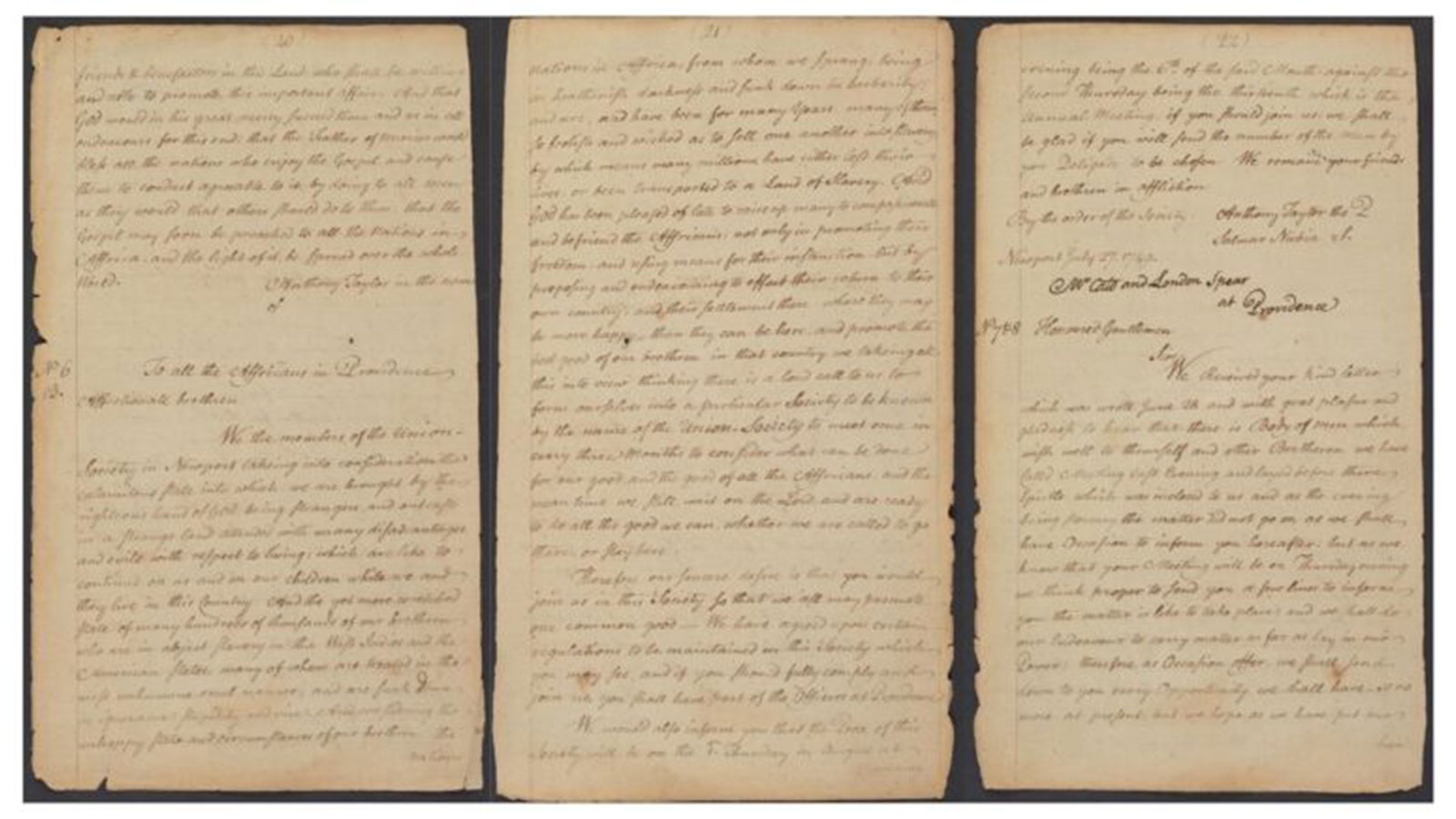
Letter addressed to members of Newport’s Free African Union Society condemning the practice of slavery in 1789. (Vol.1674B, pages 20-22, Collection of the Newport Historical Society)
‘How have I never heard of this?’
There’s another key group of experts that also say Newport’s efforts to teach about local Black history are incomplete: students.
Perhaps explaining the local history elective course’s sparse sign-ups, high schoolers said the class is so poorly advertised they weren’t aware it existed before hearing about it in conversations with The 74.
“I didn’t even know we had a Rhode Island History class,” said Dellicia Allen, a rising senior at Rogers.
In ninth grade, Allen received the same lesson that inspired Brown to make a pilgrimage to the parking lot that may have been Pastry Queen Duchess Quamino’s bakery. But in contrast to Brown, the lesson left Allen part gratified, part frustrated.
Her World History teacher had distributed a map of Newport as well as a list of famous Black figures in local history with an article to accompany each person. As students read, they dotted the map with the events and businesses that once took place there.
The activity was interesting, Allen said. But she left mulling several questions. Why had it taken until high school for teachers to celebrate Black Newporters if those figures had been there all along? And why didn’t the lesson go deeper? Her memory is that the unit seemed “skimmed over” and not taken seriously, she said.
“All this time, Newport had such a rich history. And in ninth grade … we’re just now even considering it?” Allen told The 74. “We had to wait so long … and [the lesson] lasted for, what, a day?”
See Newport Public Schools – RI History Curricula (PDF)
Cooper, her classmate, reflected similarly after a local history scavenger hunt activity in 10th grade brought her to God’s Little Acre, one of the nation’s oldest burial grounds for Africans and African Americans. Located walking distance from downtown Newport, it’s where Duchess Quamino is buried.
“I was feeling like, ‘How have I never heard of this having lived here so long?’ I would pass that graveyard every day to drive places around town and I never knew what it was,” said Cooper.
Newport Public Schools acknowledge some room for improvement. Their courses are continually evolving to better incorporate local Black history, said Ashely.
“Curriculum is never static.”

Duchess Quamino’s gravestone in God’s Little Acre (Asher Lehrer-Small)
‘Eyes wide shut’
The concrete but unfinished progress toward teaching local Black history in Newport is not out of step with the statewide push.
State Rep. Anastasia Williams, sponsor of the African heritage history legislation, is proud of the bill but also aware of its limitations: There are no teeth to punish districts that don’t comply and there’s no funding disbursed by the state for the law’s rollout. Legislators were willing to accept the bill’s provisions in the wake of George Floyd’s murder, she explained, but she doubts it would have passed if it required funding.
“You’re looking for the yard,” said Williams. “They give you an inch.”
“There are still many offsprings of slave owners that live here. … They’re afraid of everybody learning the truth,” she told The 74. “Eyes wide shut.”
Indeed, the history has been buried so deeply that Williams’s past colleague, former Rhode Island Speaker of the House Nicholas Mattiello, infamously stated in 2020 that he didn’t think there was ever “actual slavery” in the state.
Only in 2020 did voters approve a shortening of the state’s official name, which formerly was “Rhode Island and Providence Plantations.” The vote had failed as recently as 2010 and in 2020 passed by only 6 percentage points.
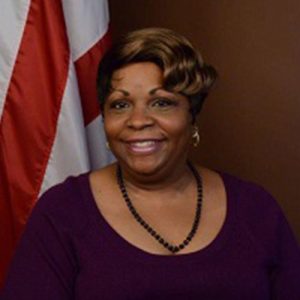
Rep. Anastasia Williams (Rhode Island General Assembly)
“The mentality of slavery remains. It’s almost like dealing with the Jim Crow South,” said Williams, who has served in the State House for nearly three decades.
The Rhode Island Department of Education has yet to plan any professional development sessions to train teachers in the new lessons, set to take effect this fall, acknowledged spokesperson Ashley Cullinane in an email to The 74.
“It would be up to the districts to determine what professional learning is needed,” she wrote.
The state has, however, worked with the Rhode Island Historical Society to develop resources for students and educators, she pointed out.
Those resources show signs of an uptick in lessons on local Black history. Over 22,000 people visited the Rhode Island Historical Society’s modules on local history from July 1, 2021 through June 31, 2022, up from 9,000 the year before, said the organization’s Education Director Geralyn Ducady. Visitors to their page of lesson plans on Black history in Rhode Island jumped from 582 to 773 during that time span.
CRT pushback
A simultaneous, opposite push has otherwise-eager educators on edge over lessons that touch on race. Rhode Island has become a hotbed in the nationwide effort to root out suspected teachings on critical race theory, a scholarly framework that examines how racism and inequality are ingrained in law and society. Right-wing activists in Rhode Island and beyond have used the term as a catch-all to attack lessons on race and racism. Three nearby school districts — South Kingstown, Westerly and Barrington — made headlines for buckling under massive record requests from community members suspicious that local classrooms were overstepping in their teachings on race and gender.
Although Rhode Island is not one of the 17 states to have enacted laws restricting such lessons, a bill to do so was introduced by state legislators in spring 2021, though it failed to pass.
Cooper, who is white, believes the right-wing pushback misses the mark — especially the claims that classroom lessons should avoid white guilt at all costs.
“In history classes, they teach … ‘The slave trade happened.’ Well, who did it? It didn’t just magically pop into place. Someone had to do all of those things,” she said. “Teaching about that will probably make a lot of white students feel guilty and feel shame … but I don’t think that means that we shouldn’t teach about it. I think if anything, that’s the reason why we have to teach about it, because people need to work through that guilt.”
“These difficult histories, if taught properly … should inspire empowerment,” said de Barros Gomes. Even if it spurs anger, “that’s a good anger, because it’s an anger that makes me want to do something.”

The future site of the Newport Middle Passage Port Marker memorial. (Asher Lehrer-Small)
‘The kids light up’
Niko Merritt is not waiting around as Newport schools scale up their lessons on local Black history.
Her children attend school in a nearby district and the mother works in Newport to strengthen the local Black community through her nonprofit Sankofa Community Connection. Among many initiatives, Merritt runs a “History and Culture Club” in Newport’s Thompson Middle School and leads youth-friendly Black history walking tours of the city.
“When we’re doing the walking tour, I’m like, ‘Shh, do you hear that?’” she said, explaining she will pretend to listen to horses galloping in the distance to spur students’ imagination. She engages them with questions like, “What do you think the person was feeling at this time?”
“The kids light up,” she said.
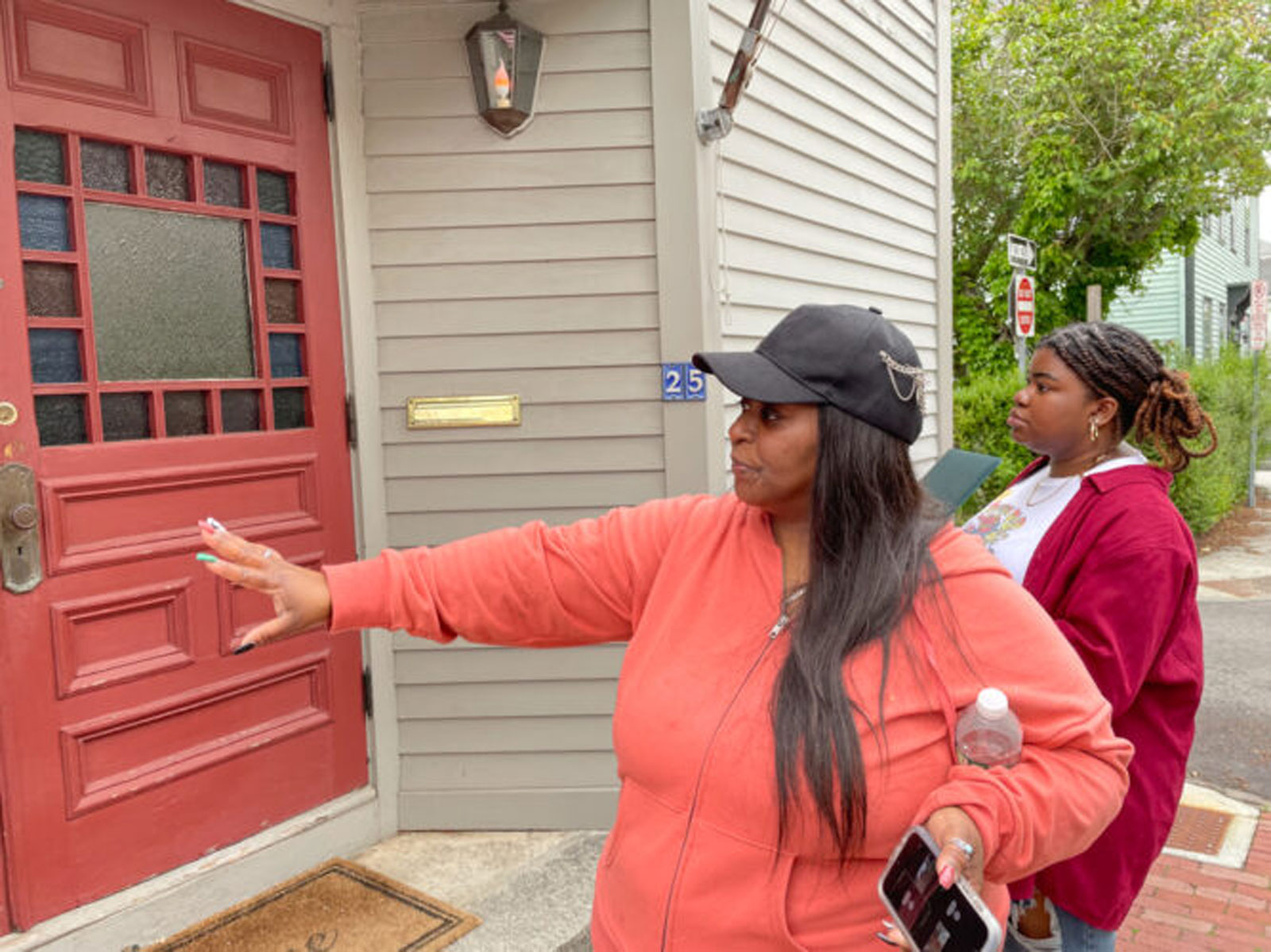
Niko Merritt and Gabrielle Brown at a stop on their walking tour. (Asher Lehrer-Small)
Called the “Rise to Redemption” tour, Merritt said her presentations give an uplifting message, each focusing on the life of one historical Black Newporter born into slavery and who, like Duchess Quamino and Newport Gardner, worked to eventually buy their freedom. Participants learn where the figure worked, lived, worshiped and socialized to give a picture of the individual’s full personhood.
“The reason why I wanted to do this tour was because I wanted people to feel seen, and to see themselves here,” said Merritt. “A lot of us feel unseen in Newport.”
After a session with middle schoolers, one student’s feedback stands out in her mind: “I feel like I belong here.”
LISTEN
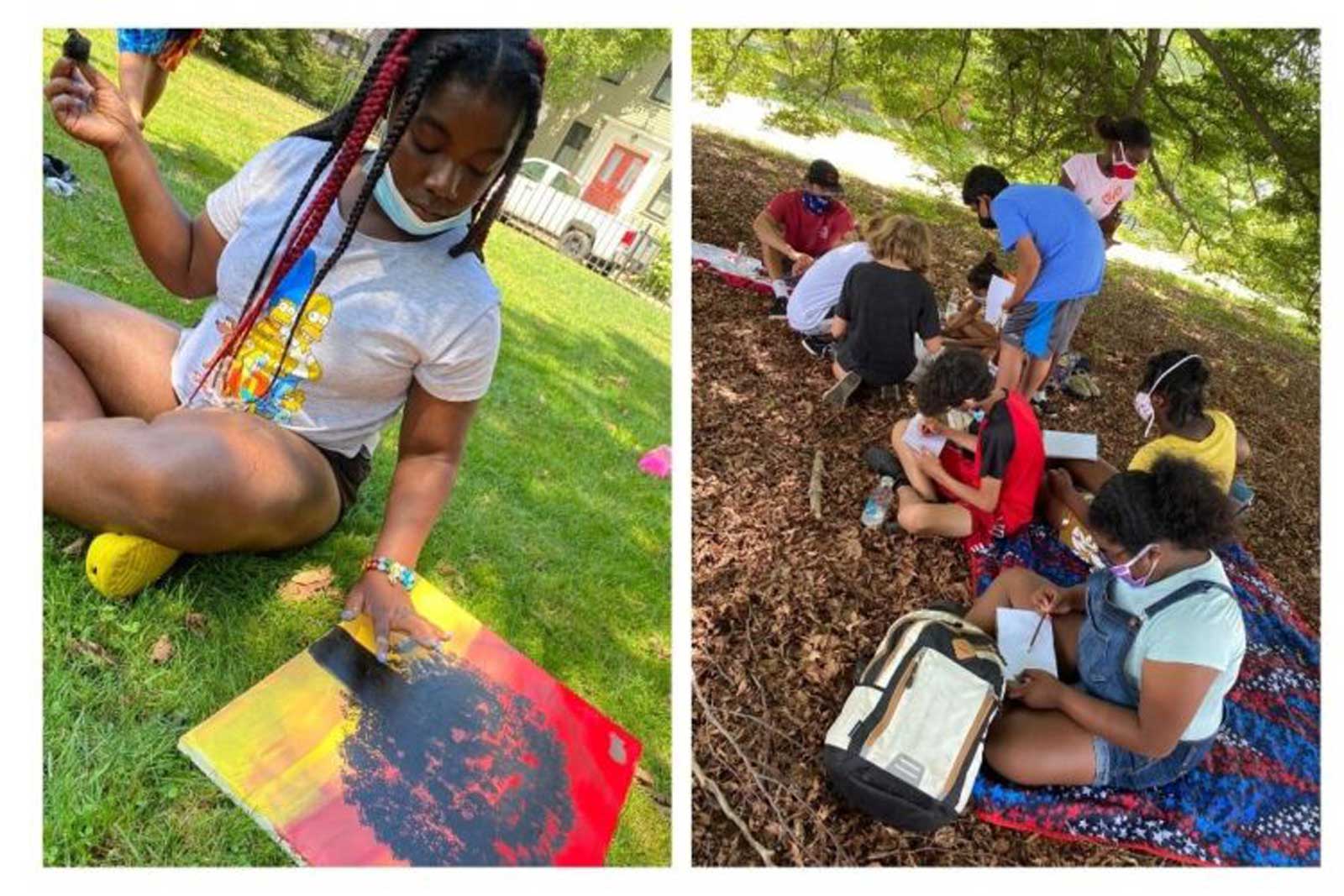
Youth paint what they imagine “Election Day,” an annual gathering of early Black Newporters, might have once looked like at the site where the event used to take place. (Niko Merritt)
After living in Newport for decades, Johnson, the former Rogers principal, is thinking about her legacy and the legacy of those who look like her in the historical city.
Long retired from the school district, she now helps lead the Newport Middle Passage Port Marker Project, an initiative working to build a public memorial downtown to acknowledge Newport’s role in the slave trade and honor African Americans’ contributions to the city.

Proposed designs for the Middle Passage Port Marker memorial which will eventually stand in downtown Newport. (Renderings by Maryann Thomspson Architects, project architects Bonder/Thompson)
“Who was here to build these buildings that are 350 years old? Do you think the English did? Of course not,” she reflected. “The African Americans, the Africans that were here. And nobody ever tells that story.”
“I want people to know that there have always been people of color, there have always been Black people in the city of Newport,” she said.
Source: The 74


